Definition: HR report can be defined as the summary of personnel data maintained on a monthly or annual basis. It helps the human resource managers to establish or identify the relevant patterns and correlations within this massive information pool.
When the companies frame various business strategies, the HR reports act as a useful tool for crucial decision-making.
For instance; An organization located in New York plans to open up a new branch in Hempstead. The management can go through the HR reports for deciding the most suitable person who can be promoted and placed in the new office of Hempstead.
Content: HR Report
HR Report for Management
When the organizations are vast and diverse, it becomes complicated to keep track of the workforce. A human resource report brings together the extensive information compiling of the individual employee data. It consumes the routine data for converting it into useful information.
Also, some of the major decisions related to recruitment of candidates, job description and job specification, promotion and appraisal, successive planning, etc. are based on the analysis of the HR reports.
HR Metrics
The companies make use of standard human resource metrics to measure the multiple KPIs (Key Performance Indicators) which facilitate the data representation and analysis.
Some of the most constant metrics adopted for this purpose include HR expense factor, hiring cost, training cost, turnover rate, turnover cost, overall employee effectiveness, overtime hours, absenteeism rate, HR return on investment and employee engagement.
CARE Criteria
While applying the HR metrics, the human resource manager should follow the CARE criteria. It initiates more meticulous decision-making and adopting the most suitable human resource measures.
Let us now discuss each element of this CARE criteria in detail below: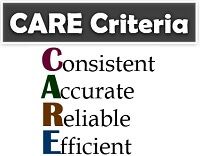
- Consistent: The metrics used for analyzing the human resource data needs to be uniform throughout the process, to ensure fair result each time.
- Accurate: Also, the dashboard information should be free from errors; and based on facts and figures.
- Reliable: The managers, directors and other organizational members should be confident and assured about the viability of these HR reports.
- Efficient: The reports so formed, should be competent and dynamic to facilitate the human resource department in analyzing the various factors.
Need for HR Report
In the present technological era, companies have extended their business operations across different nations and continents. Thus, maintaining the vast human resource data through the traditional pen and paper method seems to be unrealistic and worthless.
HR reports thus simplify data management process and facilitate the companies in the following ways: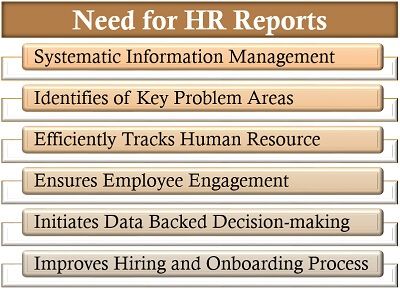
Systematic Information Management: It is a part of the MIS (Management Information System) that especially tracks the human resource efficiency in the organization. It initiates the recording, organizing, presentation and analysis of the employee data for strengthening the human resource practices.
Identifies of Key Problem Areas: Until and unless the problem is known, no one can resolve it. Therefore, the HR reports play a significant role in finding out the human resource issues like under-performance, social loafing, labour turnover or excessive absenteeism. Also, it analyzes whether the problem pertains in a particular team, department or the whole organization.
Efficiently Tracks Human Resource: With the minute details provided by these reports, the HR manager can keep an eye on each worker. It thus initiates the performance-based appraisal and a higher level of employee satisfaction.
Ensures Employee Engagement: HR reports helps the organization to track and maintain the employees’ level of commitment. Since, it provides for better performance, higher satisfaction, decrease in turnover or absenteeism.
Initiates Data-Backed Decision-making: When the complete data is available in a single report, the human resource manager can correlate the various factors and derive sensible conclusions. Such analysis can act as a basis for future human resource planning and decision-making.
Improves Hiring and On-boarding Process: By analyzing the effectiveness of the individuals, the organization can determine the weak links or under-performers. Thus, the human resource department can rectify this issue by modifying the criteria for further recruitment, along with strengthening the candidates’ on-boarding process.
Types of HR Report
There are many types of dashboards with numerous reports prepared under human resource reporting. Let us discuss some of the prominent kinds of human resource reports: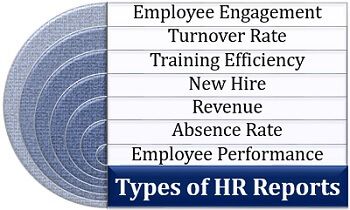
Employee Engagement: The HR department is responsible for evaluating the employee engagement level, i.e., the extent to which the workers are committed towards their task and the organization. This data is also tracked through HR reports.
Turnover Rate: Here, the company keeps a track on employee turnover. The turnover refers to the number of workers parting from the organization, due to any of the reasons.
Training Efficiency: The learning conferred to the employees for their effective performance is an essential and expensive affair. Thus, the HR reports help to maintain the record of the expenses incurred on such programs and their effectiveness.
New Hire: The data of the new entrants, relevant to the date of joining, salary, position, etc. can be maintained through HR reports.
Revenue: This sheet is used to identify the revenue generated by the company per employee. Although the employees (i.e., the supporting staff) may not directly influence the income of the company, it is a parameter to identify the organizational competency.
Absence Rate: The number of people not turning up for work, determines the level of absenteeism in the organization in a certain period. It helps the HR manager to identify the reasons behind employee’s excessive absence; like dissatisfaction from job position or managerial issues.
Employee Performance: The contribution made by the employees in the direction of organizational success can be analyzed with the help of employee performance KPIs. It includes the training cost incurred on the employees, rate of absenteeism, overtime worked and the overall labour effectiveness.
HR Report Example
Let us now get an overview of the employee performance metrics and its representation on an HR report:
The HR manager of a company XYZ Pvt. Ltd., prepared annual reports for the year 2018 concerning the following:
Employee Performance HR KPIs
She presented the following relevant data on the employee performance dashboard, indicating the five major KPIs:
Training Cost
The cost of ‘on the job’ training provided to the employees is mentioned in the below graph. It also incorporates the returns that the company will get from the skill development of the employees.
In the previous years, training was given for two years, i.e., 2013 and 2014. Also, a three years training period from 2015 to 2017 is taken into consideration for a new batch of employees.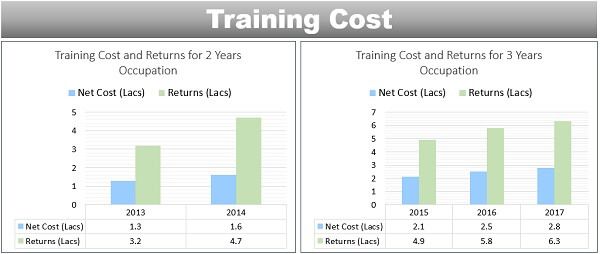
Absenteeism Rate
The total working days in a year are 249, and the average annual absenteeism of the employees is 9.9 days.
The HR manager has to ensure that the absenteeism rate remains less than 4.5%. Also, the data of the previous five years have been given below to facilitate comparative study.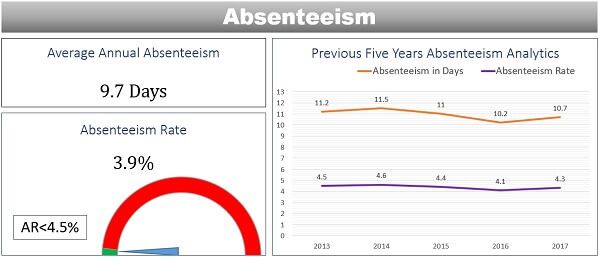
Overtime Hours
The average annual overtime done by the employees in the year 2018 is given as 74.7 hours. The average yearly overtime hours of the previous five years have been given below to facilitate comparison.
The average annual overtime done by male and female employees is also shown in the graph below: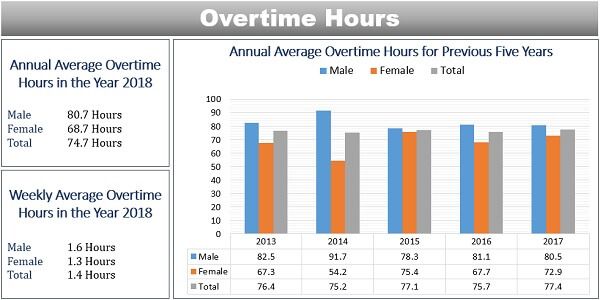
Overall Labour Effectiveness (OLE)
The employees’ efficiency could be analyzed through OLE metrics, i.e., dividing the total standard working hours by the actual number of hours for which the labour have worked.
The previous four years OLE is already available as 82% for 2014; 79% for 2015; 81% for 2016; and 85% for 2017.
Also, it is given that in the year 2018, the total number of working hours in a week was 48 hours while the employees worked for 42 hours on an average.
Thus, the OLE for the year 2018 was computed to be 88%. The graphs given below demonstrates the OLE in five years (left side) and OLE of each department in 2018 (right side):
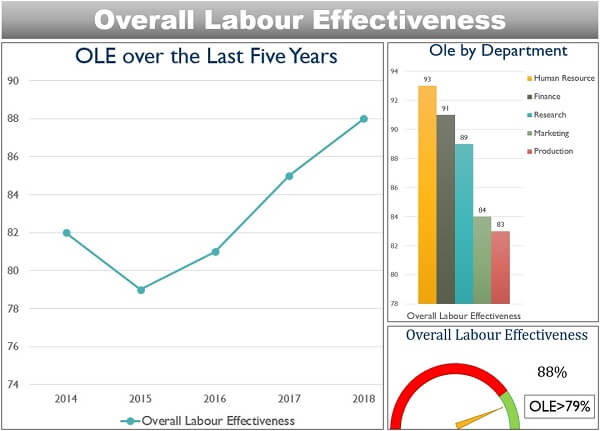
Note:
For computing the absenteeism rate, the following equation has been used:![]()
Also, to determine the overall labour effectiveness, we have considered the given formula:![]()
HR Report Template
The above KPIs can be summarized on a single HR report as given below: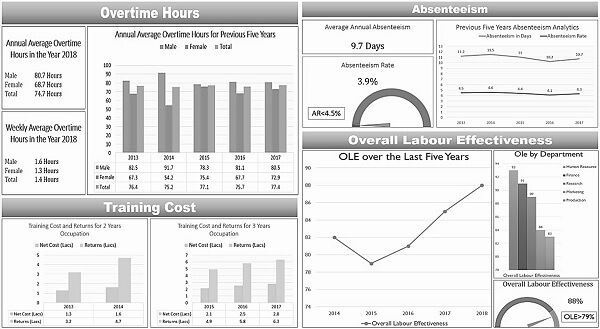
Effective HR Report
Preparing an accurate HR report is crucial for improving and simplifying the task of managing the personnel in the organization.
A weak HR report may result in misleading the human resource department, creating a blunder for the whole organization.
Therefore, the HR manager should ensure the credibility of the HR reports by keeping a check over the various loopholes.
There should be a flawless integration of technology with real-time data to achieve accuracy and reliability.
Also, these reports should be appropriately studied or analyzed to derive persuasive conclusions which can support the strategic and routine decision-making in the organization.
Ananya V says
Such a great article! Thank you for sharing. Being a newbie in the management and HR space, I often read blogs and articles like this to get new ideas in this space. Another amazing site I have been referring to is PracUp.
They have some easy to follow and pretty effective courses which help in learning a lot about English, negotiations, team communications.
You can check them out 🙂
Aarya Chalke says
I found your blog post to be very well-written and easy to understand. You provided clear and concise explanations of the different features of HR software, as well as the benefits and drawbacks of each program.